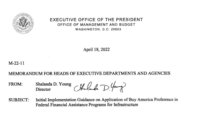The newly enacted MAP-21 transportation bill has provisions that their advocates say will fortify "Buy America" requirements for highway and transit projects. But those policy changes drew criticism from a leading Canadian industry official.
The highway title of the statute, the Moving Ahead for Progress in the 21st Century Act, has one key "Buy America" change: It states that if a road or bridge project is split into multiple contracts and at least one of those contracts receives federal funding, all contracts on that project must abide by "Buy America" mandates.
The underlying requirement for federal-aid highway projects is that they must use “steel, iron and manufactured products [that] are produced in the United States.”
Prior to MAP-21’s enactment on July 6, if an individual contract on a multi-contract highway or bridge project did not use federal funds, "Buy America" mandates did not apply to that segment.
The other "Buy America" revision is in MAP-21’s transit section. It says that before the U.S. Dept. of Transportation issues a waiver of "Buy America" requirements on a particular transit contract, it must publish “a detailed written explanation” of the decision in the Federal Register and provide “a reasonable period of time” for the public to comment on the waiver determination.
Kevin M. Dempsey, American Iron and Steel Institute (AISI) senior vice president for public policy, says the provision aims to have the Federal Transit Administration duplicate the Federal Highway Administration’s "Buy America" waiver procedures.
Dempsey says, “There has been a good process developed over time at [the Federal Highway Administration], and what that transit provision would do would try to have the transit administration follow that same practice on considering waivers.”
Industry officials say the MAP-21 highway language closes a "Buy America" loophole regarding project “segmentation.” The San Francisco-Oakland Bay Bridge project is viewed as an impetus for the change.
The project has a long history. Bart Ney, California Dept. of Transportation (Caltrans) spokesman for the Bay Bridge program, says that—back in the 1990s, in the project’s early days—officials divided it into multiple segments “because it was just too large to put out to bid” as a single contract.




Post a comment to this article
Report Abusive Comment